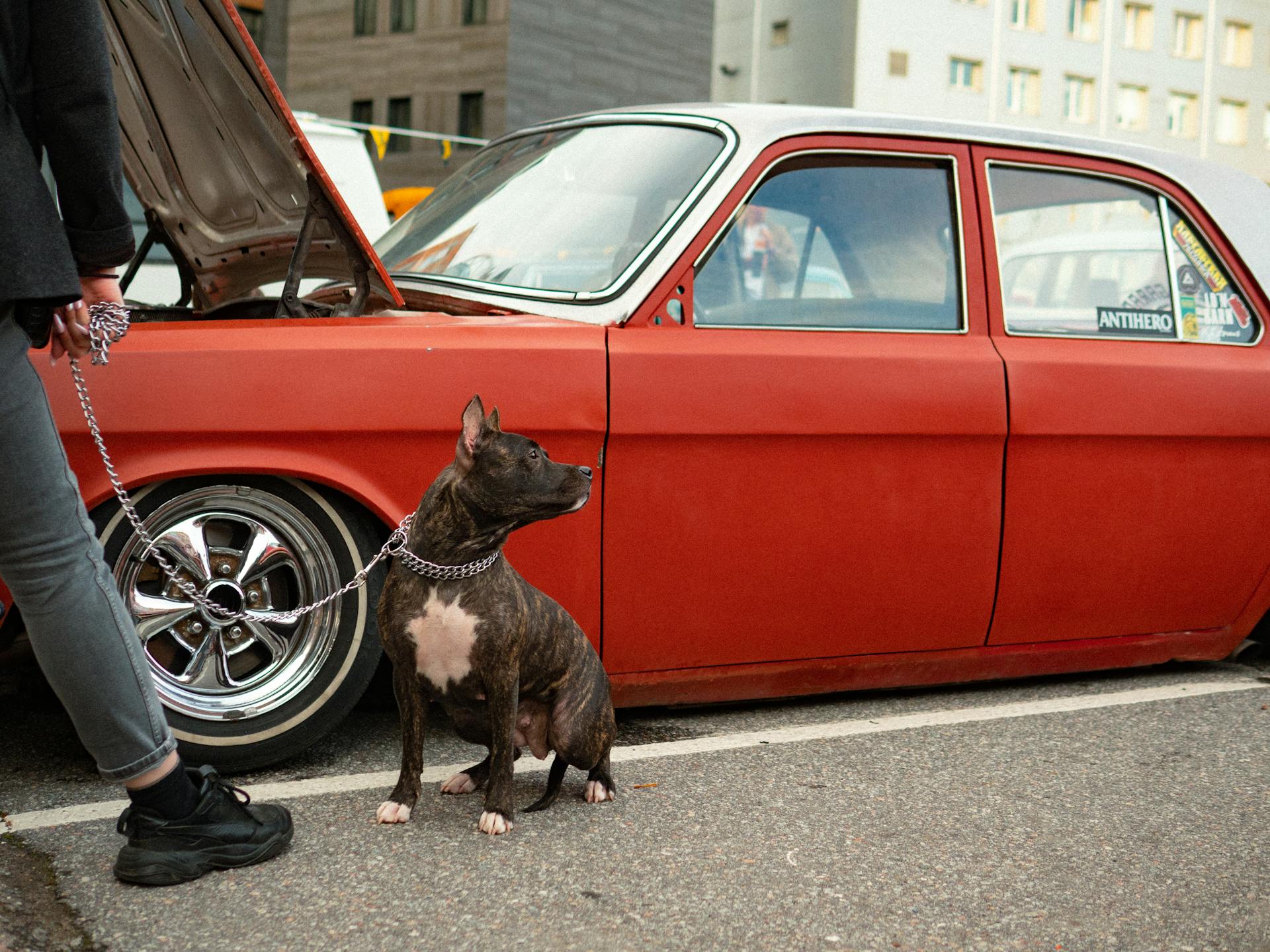
If your Shih Tzu has been diagnosed with crossed eyes, also known as strabismus, it's essential to take steps to ensure their comfort and safety.
Crossed eyes can be caused by a variety of factors, including genetics, injury, or eye infections, which can be a result of poor eye hygiene.
To prevent eye infections, it's crucial to clean your Shih Tzu's eyes regularly with a damp cloth, as recommended in the "Eye Infections in Cross Eyed Shih Tzus" section.
In some cases, surgery may be necessary to correct crossed eyes, and it's best to discuss this option with your veterinarian to determine the best course of action for your pet.
What is Cross Eyed Shih Tzu?
Cross-eyed Shih Tzus are a common sight, but what exactly is behind those adorable crossed peepers? Strabismus, or crossed eyes, is a rare condition in dogs, but it's more common in certain breeds, including the Shih Tzu.
The good news is that strabismus doesn't necessarily mean your Shih Tzu is in pain or discomfort. In fact, the condition itself is usually pain-free, but underlying causes may lead to other concerns.
Strabismus is any abnormal position of your dog's eyes, which can be a bit confusing. Typically, your dog's eyes move together, but in strabismus, one or both eyes involuntarily move in different directions.
While it may look concerning, strabismus is not a guarantee that your Shih Tzu's quality of life will suffer. In many cases, the condition doesn't affect their overall health or well-being.
A fresh viewpoint: Define Shih Tzu
Causes and Symptoms
Cross eyed Shih Tzus can be a bit of a challenge to deal with, but understanding the causes and symptoms can make a big difference in their care and treatment.
Mild strabismus, which is the medical term for cross eyedness, can have no other symptoms, but severe cases can result in loss of depth perception and even tripping over or bumping into objects.
One of the main causes of strabismus in dogs is heredity, with certain breeds being more prone to developing the condition. Pugs, for example, have been known to develop strabismus due to inherited weak muscles.
Boston terriers tend to develop inherited strabismus, and other breeds like Irish Wolfhound, Shar Pei, Akita, and Golden Retriever may also be at a higher risk.
Injuries to the eyes, head, or nerves can also cause strabismus, so it's essential to keep an eye on your Shih Tzu's behavior and health after any accidents or trauma.
Some common signs of strabismus in dogs include a lack of focus in the eyes and deviation of direction in the eye. You may notice that your Shih Tzu's eyes are looking in different directions, or that they struggle to focus both eyes on the same item.
Here are some common signs of strabismus in dogs:
- Lack of focus in eyes
- Deviation of direction in the eye
In some cases, strabismus can be caused by problems with the vestibular system, which is responsible for promoting balance. If your Shih Tzu is having trouble maintaining their balance, their body may try to compensate by moving their eyes abnormally.
Diagnosis and Testing
Diagnosing cross-eyed shih tzus requires a thorough examination of their physical and ocular health.
A physical examination is a crucial first step, as it allows veterinarians to assess the overall health of the dog.
Ophthalmic and neurological examinations are also necessary to determine the cause of the strabismus.
Blood work and diagnostic imaging, such as MRI or X-rays, may be ordered to rule out underlying conditions.
In some cases, no treatment may be necessary, or only supportive treatment may be required for mild cases.
Treatment options for cross-eyed shih tzus include addressing the underlying disease through medication or surgery.
Eye exercises can also be prescribed to strengthen the muscles around the eyes and improve alignment.
Here's a summary of the diagnostic process:
- Physical examination
- Ophthalmic examination
- Neurological examination
- Blood work
- Diagnostic imaging (MRI or X-rays)
Treatment and Recovery
Treatment for a cross-eyed Shih Tzu largely depends on the cause of the strabismus. If it's inherited, your veterinarian may not recommend any treatment, and your dog will be able to adjust on his own.
Exercises can help strengthen your dog's eye muscles, but it may take time. These exercises involve having your dog track your finger as you hold it in front of his face and slowly move it in towards his nose.
If your dog acquired the strabismus due to an injury, any immediate medical needs will be addressed first. After your dog is stabilized, your veterinarian will discuss further options for his strabismus, which may include medication to alleviate nausea due to injuries or vestibular problems.
Recovery time can be as little as 3 days and up to 14 days, depending on the severity of the injury. Your veterinarian will discuss follow-up care with you, which may include checking in after a certain period or monitoring your dog for new symptoms.
Treatment
Treatment for strabismus in dogs largely depends on the cause of the condition. If it's an inherited condition, your veterinarian may not recommend any treatment.

If your dog has inherited strabismus, your veterinarian may give you exercises to try and strengthen his eye muscles. These exercises involve having your dog track your finger as you hold it in front of his face and slowly move it in towards his nose.
In some cases, strabismus can be a cosmetic concern, and no long-term effects are to be concerned with. However, if your dog acquired strabismus without any injury or trauma, your veterinarian will treat the underlying issue.
If your dog started getting strabismus upon an injury, any immediate medical needs will be addressed first. After your dog is stabilized, your veterinarian will discuss any further options for his strabismus if necessary.
Medication can be prescribed for your dog if he is experiencing nausea due to his injuries or vestibular problems. Providing your dog with a lot of light can also benefit his recovery by helping him use visual cues for distance, position, and more.
Recovery

Recovery is a crucial part of your dog's journey back to normal.
Recovery time can be as little as 3 days and up to 14 days, depending on the severity of the injury or if it's inherited.
Your veterinarian will discuss follow-up care with you, which may include checking in after a certain period or monitoring for new symptoms.
Providing your dog with space and recommended adaptations can be beneficial to their recovery.
Your dog should make a full recovery within a few weeks, adapting to their new sensory input during this time.
Keeping their environment comfortable and safe will also help with their recovery.
Veterinary Care
When adopting a cross-eyed Shih Tzu, it's essential to consider their specific veterinary care needs.
Their short, flat face can make breathing and eating more difficult, so regular check-ups with a veterinarian are crucial.
Shih Tzus are prone to eye problems, including cherry eye, which can be treated with surgery.
Eye exams every 6-12 months are recommended to monitor their eye health.
Shih Tzus can be prone to dental issues due to their small jaw and crowded teeth.
Daily brushing and regular dental cleanings can help prevent tartar buildup and gum disease.
As Shih Tzus age, they can be susceptible to cataracts, glaucoma, and other age-related eye problems.
Regular eye exams can help detect these issues early on, reducing the risk of complications.
Shih Tzus typically live between 10-16 years, so it's essential to find a veterinarian who will care for them throughout their lifespan.
Eye Health
As a Shih Tzu owner, it's essential to be aware of the potential eye health issues that can affect your furry friend. Certain breeds, including Shih Tzus, are prone to eye problems.
Some breeds, such as Pugs, Boston terriers, Irish Wolfhounds, Shar Peis, Akitas, and Golden Retrievers, are at a higher risk of developing strabismus, also known as cross-eyed.
Head injuries, trauma to the eye, falls, and car accidents can result in strabismus as a side effect. If your dog has experienced any of these, it's crucial to have them checked by a veterinarian.
Your dog's vestibular system plays a crucial role in promoting balance, and problems with this system can lead to strabismus. Common causes include inner ear infections, antibiotic side effects, thyroid issues, and brain conditions.
Here are some breeds that are prone to inherited strabismus:
- Pugs
- Boston terriers
- Irish Wolfhound
- Shar Pei
- Akita
- Golden Retriever
Regular eye tests by a veterinarian will help determine whether your dog is at risk of going blind, the cause of the problem, and whether the condition is treatable.
Protecting
Protecting your cross-eyed Shih Tzu requires extra care, especially when it comes to their eyes.
Dust in the wind can irritate their eyes, so be sure to keep your car windows closed when driving with your puppy.
Preventing shampoo and other products from getting into their eyes is crucial, and you can purchase over-the-counter eye ointments to protect them.
Keep the hair around their eyes clipped short to prevent irritation and accidental skin cuts.
Be extremely careful when clipping their hair, as most Shih Tzus have a deep skin fold near their eyes.
High winds can create dangerous conditions for your Shih Tzu, so avoid areas with blowing dust, debris, pollen, or particles.
Preventing dog fights is also essential, as one quick bite to the face can permanently damage an eye.
I've seen firsthand how easily Shih Tzus can get into mischief, so it's essential to train them to stay on the path and avoid areas where they could harm their eyes.
Consider reading: Shih Tzu Skin Problems Black Spots
General Information
Strabismus, also known as cross-eyed, is an uncommon disorder in dogs that affects their eye alignment.
Strabismus occurs when one or both eyes are not correctly aligned, giving the appearance of crossed eyes or eyes not pointing in the same direction together.
Some causes of strabismus in dogs are hereditary and present at birth, while others may be caused by injury, inflammation, infection, or neurological disorders.
Associated symptoms of strabismus include difficulty judging distance, bumping into objects, squinting, redness, and pain of the affected eye.
Here are some common symptoms of strabismus in dogs:
- Difficulty judging distance
- Bumping into objects
- Squinting
- Redness
- Pain of the affected eye
Facts About

Shih Tzus have a unique vision that's worth understanding. Their eyes are prone to a condition called strabismus, which affects the alignment of their eyes.
Strabismus is caused by an underlying disease mechanism affecting the muscles or nerves that control eye movement. In some cases, it's hereditary and present at birth.
Shih Tzus with strabismus may exhibit difficulty judging distance, bumping into objects, squinting, redness, and pain of the affected eye. These symptoms can be challenging to manage if left untreated.
Investigating strabismus involves a comprehensive examination, including physical, ophthalmic, and neurological checks, as well as blood work and diagnostic imaging. Treatment options depend on the severity and underlying disease process.
Here are some possible causes of strabismus in Shih Tzus:
- Hereditary factors
- Injury
- Inflammation
- Infection
- Neurological disorders
Treatment for strabismus can range from mild to severe cases, and may include topical or oral medication, as well as eye strengthening exercises. In some cases, treatment may not be necessary if the condition is mild.
About How to

If you're new to gardening, it's essential to start with a well-draining potting mix to prevent waterlogged soil. This mix can be made at home by combining equal parts of peat moss, perlite, and vermiculite.
To create a trellis for climbing plants, use a sturdy wooden or metal frame and cover it with chicken wire or a mesh material to keep the plants contained. This will also help to keep pests away.
Before planting, make sure to water the soil thoroughly to settle the mixture and remove any air pockets. This will ensure that the roots can grow evenly.
For a simple DIY irrigation system, use a plastic bottle and some tubing to create a self-watering planter. Simply cut the bottom off the bottle and place it in the soil, then attach the tubing to the bottle's neck.
To keep your garden organized, use a gardening journal to track your planting schedule, note weather patterns, and record your harvests. This will help you plan for future seasons and identify areas for improvement.
Frequently Asked Questions
How long do Shih Tzu crosses live?
Shih Tzu crosses typically live between 10 to 16 years, inheriting the long lifespan of their parent breed. However, their lifespan may vary depending on individual health factors and hybrid vigor.
What does it mean when a dog is cross-eyed?
Cross-eyed in dogs can be a sign of strabismus, a condition caused by abnormalities in eye development or muscle function, or other underlying issues such as nerve damage or congenital conditions
Sources
Featured Images: pexels.com


